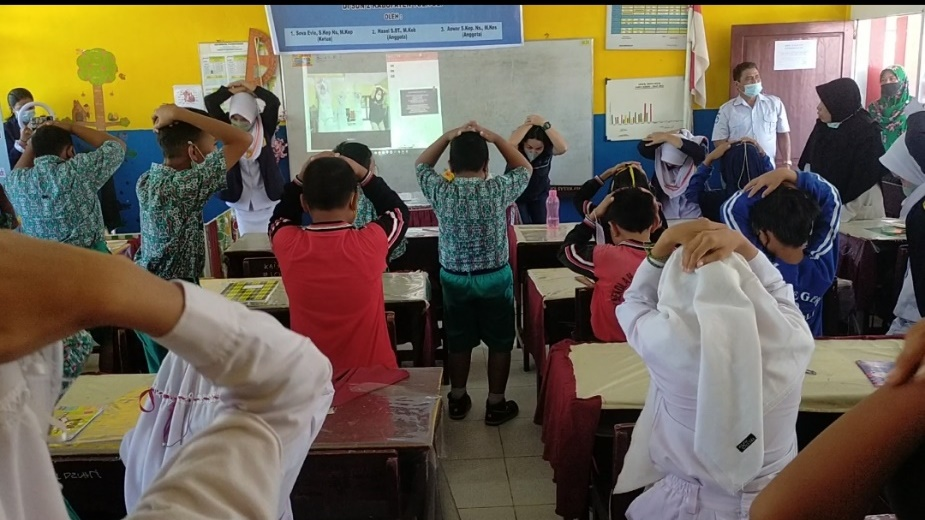Pendidikan Kebencanaan dan Simulasi Bencana Gempa Bumi sebagai Upaya Mengurangi Dampak Bencana Gempa Bumi
Disaster Education and Earthquake Disaster Simulation as an Effort to Reduce the Impact of Earthquake Disasters
Keywords:
Pengetahuan, Simulasi, Siaga, Gempa bumiAbstract
Massive earthquakes around the world cause injuries, loss of life and damage to infrastructure. Among the fatalities due to the earthquake disaster are the elderly and children the most. Children are among the most vulnerable groups in disaster situations. They have limited ability and resources to control or prepare themselves when they feel afraid, so they are very dependent on parties outside themselves to be able to recover from a disaster. The impacts and losses caused by the earthquake are caused by the lack of readiness of the community or the surrounding community in anticipating these problems. The purpose of community service activities is to increase the preparedness of students to face earthquake disasters so that they can understand and take steps to save when an earthquake occurs and can reduce the number of victims. . The target is 55 students at SDN 2 Tolitoli. From the results of the post test carried out, it was obtained for knowledge that there was an increase in score where the average value obtained by students was in the 80-100 range from the 40-50 range during the pre test. Meanwhile, for behavior in the pre test, <T Mean becomes >T Mean during the post test. It is hoped that the earthquake disaster simulation can be carried out periodically every semester.
ABSTRAK
Gempa-gempa dahsyat di seluruh dunia menyebabkan korban luka-luka, kerusakan infrastruktur maupun hilangnya nyawa. Korban yang paling banyak adalah orang tua dan anak-anak. Anak termasuk dalam kelompok paling rentan dalam situasi bencana Dampak dan kerugian yang ditimbulkan oleh gempa bumi disebabkan karena kurangnya kesiapan masyarakat atau komunitas sekitar dalam mengantisipasi masalah tersebut. Tujuan dalam kegiatan pengabmas untuk meningkatkan kesiapsiagaan siswa/siswi menghadapi kebencanaan gempa bumi sehingga dapat memahami dan melakukan langkah-langkah dalam penyelamatan ketika terjadi gempa bumi dan dapat menurunkan jumlah korban, Dengan metode pelaksanaan adalah ceramah, tanya jawab, diskusi dan simulasi siaga bencana gempa bumi. Yang menjadi sasaran adalah siswa/siswi di SDN 2 Tolitoli berjumlah 55 orang. Dari hasil post test yang dilakukan didapatkan untuk pengetahuan terjadi kenaikan skor dimana nilai rata-rata yang diperoleh siswa/siswi berada dari rentang 40-50 saat pre test menjadi rentang 80-100 pada post test. Sedangkan untuk Perilaku pada pre test didapatkan < Mean dan pada post test meningkat menjadi >T Mean. Diharapkan simulasi bencana gempa bumi dapat dilaksanakan secara periodik setiap semester.
References
Abdillah, A. J. (2020). Implementation of physics learning media based on android integrated earthquake disaster education to enhance problem solving abilities and natural disaster preparedness. In Journal of Physics: Conference Series (Vol. 1440, Issue 1). https://doi.org/10.1088/1742-6596/1440/1/012027
Ana Delicado., Jussara Rowland., Susana Fonseca1., Ana Nunes de Almeida., Luı´sa Schmidt., Ana Sofia Ribeiro, (2017). Children in Disaster Risk Reduction in Portugal: Policies, Education, and (Non) Participation. International Journal of Disaster Risk Science. 8(3): 246-257. https://doi.org/10.1007/s13753-017-0138-5
Arlym, L. (2019). A policy model of preparedness the general hospital in reducing victims of earthquake and tsunami disasters in siberut mentawai Island, Indonesia. International Journal of Recent Technology and Engineering, 8(3), 89–93. https://doi.org/10.35940/ijrte.C3890.098319
Bordogna, E. (2020). Education as reconstruction. school typology in post-earthquake reconstruction in central Italy. In Research for Development (pp. 127–137). https://doi.org/10.1007/978-3-030-33687-5_12
Daud (2014). Penerapan Pelatihan Siaga Bencana Dalam Mningkatkan Pengetahuan Sikap dan Tindakan Komunitas SMA N 5 Banda Aceh. Jurnal Ilmu Kebencanaan Pasca Sarjana Universitas Syiah Kuala. 1(1). 26-34. Retreived from https://jurnal.unsyiah.ac.id/JIKA/article/view/2470/2323
Devi & Sharma. (2015). Awareness on earthquake preparedness: A key to safe life. International Journal of Nursing Research and Practice. 2(2), 1-6. Retreived from http://www.uphtr.com/IJNRP/issue_files/2015%20i2,%20v2%204%20Ms%20Asha.pdf
Goto, K. (2021). Ten years after the 2011 Tohoku-oki earthquake and tsunami: Geological and environmental effects and implications for disaster policy changes. In Earth-Science Reviews (Vol. 212). https://doi.org/10.1016/j.earscirev.2020.103417
Hosseini, K. A. (2020). From “Earthquake and safety” school drills to “safe school-resilient communities”: A continuous attempt for promoting community-based disaster risk management in Iran. International Journal of Disaster Risk Reduction, 45. https://doi.org/10.1016/j.ijdrr.2020.101512
Inoue, Y. (2019). Adverse childhood experiences, exposure to a natural disaster and posttraumatic stress disorder among survivors of the 2011 Great East Japan earthquake and tsunami. Epidemiology and Psychiatric Sciences, 28(1), 45–53. https://doi.org/10.1017/S2045796017000233
Lam, L. M. (2019). Resilience and disaster governance: Some insights from the 2015 Nepal earthquake. International Journal of Disaster Risk Reduction, 33, 321–331. https://doi.org/10.1016/j.ijdrr.2018.10.017
Lian, Panpan., Zhuo, Zhenyu., Qi, Yanbin., Xu, Dingde., Deng, Xin (2021). The Impacts of Training on Farmers’ Preparedness Behaviors of Earthquake Disaster—Evidence from Earthquake-Prone Settlements in Rural China. Agriculture; Basel. 11(8). 726. https://doi.org/10.3390/agriculture11080726
Lu, X. (2020). A new urban earthquake disaster simulation method: City-scale nonlinear time-history analysis. Kexue Tongbao/Chinese Science Bulletin, 65(11), 1055–1062. https://doi.org/10.1360/TB-2019-0679
Martin, M. L, (2010) Child participation in disaster risk reduction: The case of floodaffected children in Bangladesh. Third World Quarterly. 31(8), 1357-1375. http://dx.doi.org/10.1080/01436597.2010.541086
Musacchio, G., Falsaperla, S., Bernhardsdóttir, A.E., Ferreira, M.A., Sousa, M.L., Carvalho, A., Zonno, G. Education., (2015). Can a Bottom-up Strategy Help for Earthquake Disaster Prevention? Bull. Earthq. Eng. 2015, 14, 2069–2086. https://doi.org/10.1007/s10518-015-9779-1
Muttarak, R., Lutz, W. (2014). Is Education a Key to Reducing Vulnerability to Natural Disasters and Hence Unavoidable Climate Change? Ecol. Soc. 19, 42. http://dx.doi.org/10.5751/ES-06476-190142
Navakanesh, B. (2019). Earthquake education through the use of documentary movies. Frontiers in Earth Science, 7. https://doi.org/10.3389/feart.2019.00042
Nikku, B.R, (2012) Children's rights in disasters: Concerns for social work-Insights from South Asia and possible lessons for Africa. International Social Work. 56(1), 51-66. https://doi.org/10.1177/0020872812459064
Panic, M., Kovacevic-Majkic, J., Miljanovic, D., Miletic, R. (2013). Importance of Natural Disaster Education—Case Study of the Earthquake near the City of Kraljevo: First Results. J. Geogr. Inst. Jovan Cvijic SASA, 63, 75–88. https://doi.org/10.2298/IJGI121121001P
Rahmat Tryono., Urip Setiyono.,Indra Gunawan., Priyobudi.,Tatok Yatimantoro., Rudi Teguh Imanata., Mohamad Ramdhan., Hidayanti., Septa Anggraini., Resty Herdiani Rahayu., Purnomo Hawati., Debi Safari Yogaswara., Admiral Musa Julius., Mila Apriani., Muhamad Harvan., Gloria Simangunsong., Tribowo Kriswinarso (2019). Katalog Gempa Bumi Signifikan dan Merusak Tahun 1821-2018. Pusat Gempa Bumi dan Tsunami. Badan Meteorologi dan Geofisika; Jakarta https://cdn.bmkg.go.id/Web/Katalog-Gempabumi-Signifikan-dan-Merusak-1821-2018.pdf
Sakuma, A. (2020). Trajectories for Post-traumatic Stress Disorder Symptoms Among Local Disaster Recovery Workers Following the Great East Japan Earthquake: Group-based Trajectory Modeling. Journal of Affective Disorders, 274, 742–751. https://doi.org/10.1016/j.jad.2020.05.152
Sakurai, A. (2020). Impact evaluation of a school-based disaster education program in a city affected by the 2011 great East Japan earthquake and tsunami disaster. International Journal of Disaster Risk Reduction, 47. https://doi.org/10.1016/j.ijdrr.2020.101632
Sardjunani N and Hadi S (2010). Country Experience: Advancing Child Rights in Disaster Risk Reduction Initiatives in Insarannesia. (Pertemuan Tingkat Tinggi pada Perlindungan Hak Anak di Asia dan Pasifik; Beijing; RRC. Retreived from http://hdl.handle.net/11617/6492
Sohrabizadeh, S. (2019). Earthquake preparedness in higher education structures: A case study of an academic institute in Tehran, Iran. International Journal of Disaster Resilience in the Built Environment, 10(2), 175–187. https://doi.org/10.1108/IJDRBE-12-2018-0049
Sumy, D. F. (2022). Typology development of earthquake displays in free-choice learning environments, to inform earthquake early warning education in the United States. International Journal of Disaster Risk Reduction, 73. https://doi.org/10.1016/j.ijdrr.2022.102802
Tabata, T. (2019). Earthquake disaster waste management reviews: Prediction, treatment, recycling, and prevention. In International Journal of Disaster Risk Reduction (Vol. 36). https://doi.org/10.1016/j.ijdrr.2019.101119
Toyoda, Y. (2021). Framework for utilizing disaster learning tools classified by real and virtual aspects of community space and social networks: Application to community-based disaster risk reduction and school disaster education on earthquakes in Japan for during- and pos. Progress in Disaster Science, 12. https://doi.org/10.1016/j.pdisas.2021.100210
Wang, A. (2020). Corporate investor confidence in the aftermath of a mega natural disaster: An empirical study of the 2008 Wenchuan earthquake. Safety Science, 125. https://doi.org/10.1016/j.ssci.2020.104620
Widi E, Endina, Yolanda (2018). Mobile Educational Game for Earthquake Disaster Preparedness in Elementary School ARPN Journal of Engineering and Applied Sciences. 13(7). 2612-2618. Retreived from http://www.arpnjournals.org/jeas/research_papers/rp_2018/jeas_0418_6974.pdf
Yeon, D. H. (2020). The effects of earthquake experience on disaster education for children and teens. International Journal of Environmental Research and Public Health, 17(15), 1–14. https://doi.org/10.3390/ijerph17155347
Zuhdi, M., Makhrus, M., Sutrio, S. And Wahyudi, W., (2019). Sosialisasi Tentang Mitigasi Bencana Tsunami dan Gempa Lombok Di Jempong Baru, Sekarbela, Mataram. Jurnal Pengabdian Magister Pendidikan IPA, 2(1).

Published
How to Cite
Issue
Section
Copyright (c) 2022 Sova Evie, Hasni, Azwar, Saman

This work is licensed under a Creative Commons Attribution-ShareAlike 4.0 International License.
Authors who publish with Poltekita: Jurnal Pengabdian Masyarakat agree to the following terms:
- Authors retain copyright and grant the journal right of first publication with the work simultaneously licensed under a Creative Commons Attribution License (CC BY-SA 4.0) that allows others to share the work with an acknowledgment of the work's authorship and initial publication in this journal.
- Authors are able to enter into separate, additional contractual arrangements for the non-exclusive distribution of the journal's published version of the work (e.g., post it to an institutional repository or publish it in a book), with an acknowledgment of its initial publication in this journal.
- Authors are permitted and encouraged to post their work online (e.g., in institutional repositories or on their website) prior to and during the submission process, as it can lead to productive exchanges, as well as earlier and greater citation of published work.

This work is licensed under a Creative Commons Attribution-Share Alike 4.0 International License
You are free to:
- Share, copy and redistribute the material in any medium or format
- Adapt, remix, transform, and build upon the material for any purpose, even commercially.
- The licensor cannot revoke these freedoms as long as you follow the license terms.

1.png)


